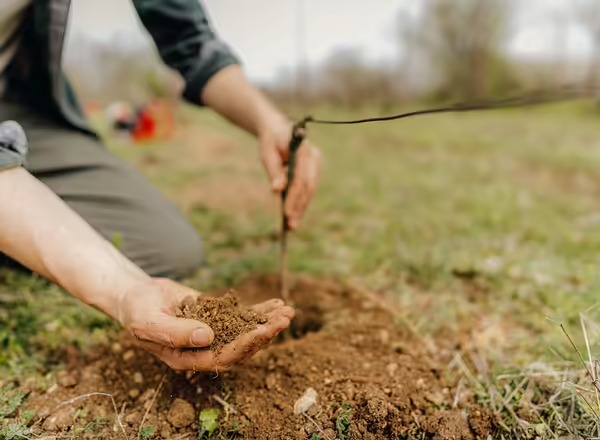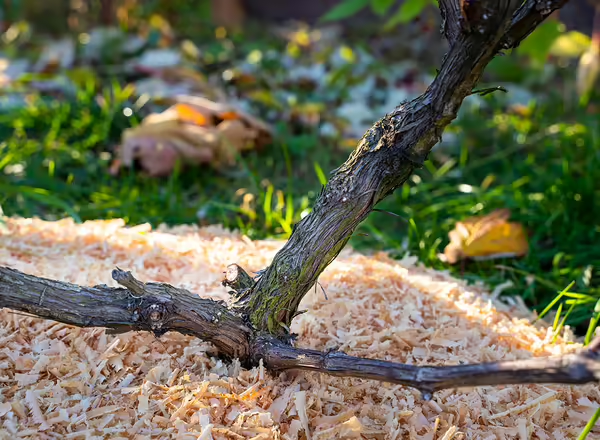
Grape vines should be planted in the early spring as soon as the soil can be prepared. Cut off any long or broken roots so that the remaining roots can be spread evenly in the planting hole. Set the plant slightly deeper than the depth it grew in the nursery. After planting, prune as directed in the pruning section. Space the plants eight feet apart within the row and ten feet between rows. If grafted vines are used for phylloxera resistance, set the graft union 4 to 6” above the soil level.
Have your soil tested prior to planting. Before planting, add nutrients on the basis of this test. If the selected cultivars are vigorous and produce excessive growth, do not apply fertilizer. The use of excessive fertilizer can encourage rank growth that does not mature properly, is unproductive, and is likely to be damaged during cold winters. Canes that grow moderately tend to mature early and produce better crops than excessively vigorous canes.
If the vines are not vigorous growers, a commercial fertilizer may be used. Apply two ounces of a 10- 10-10 fertilizer (or equivalent) around each vine shortly after planting. In the early spring (March) of the second year, apply four ounces; the third year, eight ounces; and thereafter, one pound per plant. Distribute the total amount of the fertilizer around the plant in 3 applications (March, May and July). For mature plants, the third application may not be necessary if the vines are vigorous and growing properly. If the soil is high in potassium and phosphorus, 33% nitrogen fertilizer (ammonium nitrate [NH4 NO3 ]) can be substituted at one-third the above rates.

Cultivate the young grape planting for the first year. Do not cultivate deeper than three inches around the plants because the roots are rather shallow.
After the vines are established, the grapes can be mulched with straw, sawdust, leaves, or compost. Caution must be used when mulching grape vines on heavy, wet, or highly fertile soils. Mulching may encourage overly vigorous canes that will fail to mature properly.

The first season of growth can be supported by a one-inch by one-inch wooden stake. A trellis or arbor should be constructed before the second growing sea- son. The grape planting is more or less permanent, therefore the support trellis should be built to last twenty or more years. The structure, therefore, must be strong enough to bear the weight of mature vines as well as a full crop.
The most common training system is the four-cane Kniffin system. A trellis for this system consists of two wires, approximately three feet apart vertically, supported by posts set about twenty to thirty feet apart in the row. Nine- or ten-gauge galvanized wire is suggested. The lower wire should be three feet above the ground, and the top wire about five and a half to six feet above the ground. Durable wood posts (cedar, locust, white oak, Osage orange, or green-tinted CCA-treated timber rated for ground use) should be a minimum of three inches in diameter at the top and eight to eight and a half feet long. The posts should be set two and a half to three feet in the ground; for long rows, heavier posts should be used for the ends of the trellis. The end posts should be five to six inches or more in diameter at the top, and they should be nine feet long so that they can be set a full three feet deep. The end posts should be well braced to keep the trellis wires from sagging (Figure M-24.). Metal posts also may be used for supporting trellis wires.
Grapes can be trained satisfactorily on latticed arbors, fences, or other suitable structures. For some homeowners, the shading provided by grape vines growing over arbors may be as important as the fruit crop.
Grapes are one of the most sensitive plants to many chemicals, particularly herbicides containing 2,4-D. Enough 2,4-D can drift one-half to one mile by air and can ruin your grape crop. Do not apply fertilizer or herbicide that contains 2,4-D to the lawn near grapes. Avoid using any 2,4-D (or sprayers that have contained 2,4-D) in the vicinity of grapes. Injury may be indicated by misshapen leaves, tendrils, and young shoots. The leaves may have sawtooth edges and may be narrow and fan shaped. The clusters may ripen unevenly or not at all. The symptoms appear one to three weeks after exposure to the fumes
To have a successful fruit garden, you must be aware of many diseases and insect pests and be prepared to control them. Home fruit growing is usually an avocation rather than a vocation, and a person often does not have the time or inclination to spray pesticides.
Thus, most pest-control programs for the home fruit garden are quite limited, although they can also be extremely successful.
Pest control begins with the selection of a suitable planting site and consideration of previous cropping history, followed by selection of disease-resistant cultivars, use of healthy disease-free planting stock, and, finally, the use of good cultural and sanitation practices. These factors are discussed on the following pages as they apply to each crop. The use of pesticides to control certain insects and diseases is often necessary because sanitation practices are not always adequate by themselves. One well-timed chemical application may mean the difference between a good crop and no crop at all. Home Fruit Pest Control and University of Illinois Extension Pest Management for the Home Landscape contain spray recommendations.